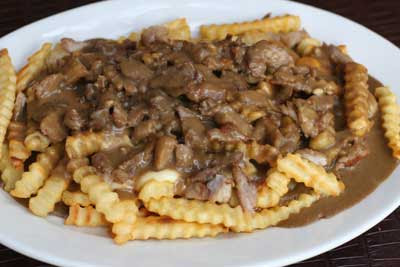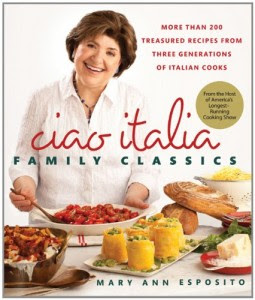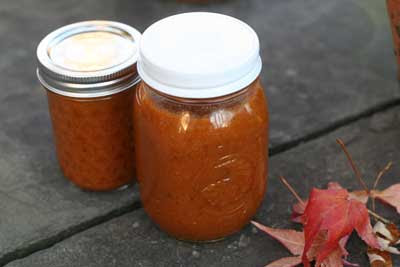 From Cake Ladies: Celebrating a Southern Tradition by Jodi Rhoden....
From Cake Ladies: Celebrating a Southern Tradition by Jodi Rhoden....As I sat at the counter of the Pine Apple Grocery in
Pine Apple, Alabama, James Huggins explained the origin of the town’s name. “Back in earlier days, there was a stage coach route through the area, and a stopping place here – a watering hole for the horses with a pine tree and an apple tree, so they called it Pine Apple.” Although the 2000 census listed Pine Apple as having 148 residents, a patron at the grocery (who was also a member of the City Council) guessed that the population had dwindled to about 70. Downtown Pine Apple, located at the corner of Pineapple Highway and Banana Street, has a post office, a town hall, a library, some empty storefronts, and the Pine Apple Grocery, host of the annual
Pine Apple Hunter Appreciation Day. It was through James at the grocery that I met the cake lady Lois Mims, who lives just down the street. Lois makes cakes for her friends and family, and, like many cake ladies, is often commissioned to bake cakes for sale. Lois has a reputation as a cook in her community. “They all call me Big Mama,” she says. “Grown folk call me Big Mama. That’s because I used to do a lot of cooking and feed a lot of people, and I didn’t mind doing it. I enjoy feeding people. It makes me feel good.”
Like many other cake ladies, Lois doesn’t use written recipes; instead she relies on her memory, her intuition, and her experience to craft the perfect cake. “You talking about a recipe? I ain’t got a recipe. I just put my stuff in there, take my head, and use it.” Within minutes of meeting her, Lois proceeded to tell me how she makes several of her cakes, listing from memory the ingredients and methods for egg pie, cooked caramel icing, applesauce spice cake, yellow cake, lemon pie, coconut pie, and pineapple upside-down cake.
She recounted a baking story where she had to rely on intuition (and prayer) to get the right results: “One time I was making pies for some people, but I don’t have money to buy pie crust, and I can’t make them like my mama, so I said, ‘Lord, help me to make these pie crusts for these people because I don’t have no money.’ So I got up and I rolled them pie crusts, and they came out right. They say the pies were nice, they were good.”
Like many bakers, Lois credits her mother with teaching her to bake by feel rather than from recipes. She says, “There was a friend my mother used to cook for. My mother’s name was Allie, and when I was a little girl, he’d say, ‘Allie, she cook out the book!’ And I always thought, I wonder what he’s saying? After I thought about it when I was grown, I said, ‘I know what he’s saying! He’s talking about how good my mamma cooked, and she didn’t have to use a book’”
Lois Mims stopped baking this cake for a few years, but then her children started to ask for it again. Lois bakes her pineapple upside-down cake in a well-seasoned 9-inch cast-iron skillet.
Ingredients:For the topping:1/2 stick (1/4 cup) butter
1 cup packed light brown sugar
1 15 oz. can of pineapple slices, drained and juice reserved
1 small jar of maraschino cherries (about 15), stemmed
For the cake:1 stick (1/2 cup) butter
2 cups self-rising flour
1 1/2 cups sugar
2 large eggs, lightly beaten
3/4 cup milk
2 tbsp reserved pineapple juice from can
Preparation: - Position a rack in the center of the oven and preheat the oven to 375 degrees Fahrenheit.
- To melt the butter for the cake, place 1 stick of butter in a 9-inch cast-iron skillet and set it in the preheating oven until the butter is melted but not sizzling. Pour the melted butter into a heat-proof mixing bowl, and set aside. Allow the butter to cool, but not solidify.
- Place the remaining ½ stick of butter in the skillet and place the skillet back in the oven, until the butter is melted but not sizzling. Remove the skillet from the oven, and add the brown sugar and stir until the sugar is dissolved; spread the brown sugar mixture into an even layer in the bottom of the skillet.
- Place one pineapple ring in the center of the skillet on top of the brown sugar mixture. Arrange five pineapple rings in a circle around the center ring. Cut the remaining pineapple rings in half, and arrange the half-circles around the outside edge of the skillet, pressing them against the sides of the pan, cut ends up. Place a maraschino cherry in the center of each pineapple ring, and rest one cherry in each half-ring against the sides of the pan. Set aside.
- Sift the flour and sugar together into the mixing bowl. Pour in the melted and cooled butter, eggs, milk, and pineapple juice. Stir with a wooden spoon until ingredients are just combined and few lumps remain. Gently pour the mixture over the fruit in the skillet. Scrape down the bowl with a spatula to be sure to get all of the batter out of the bowl and into the skillet. Use the spatula to evenly distribute the batter, cover all of the fruit, and level the batter’s surface. Place the skillet on the center rack of the hot oven.
- Bake for 40 to 45 minutes, or until the top of the cake is a deep golden brown and a knife inserted into the center batter comes out clean. Remove the skillet from the oven and set it aside onto a heat-proof surface to cool for 5 minutes.
- Run a knife around the outside edge of the cake to release any cake stuck to the pan. Place a heat-proof plate, inverted, over the skillet. With gloved hands, grasp both sides of the skillet and plate together, and invert the cake onto the plate. Remove the skillet. If any pieces of fruit are stuck to the skillet, quickly transfer them back onto the cake with a fork. The brown sugar glaze should drizzle slightly around the cake. Allow to cool, then serve immediately. Pineapple Upside-Down cake will keep for two or three days at room temperature, or for up to a week covered and refrigerated.
PREP TIME: 20 minutes
BAKING TIME: 40 to 45 minutes
COOLING TIME: 5 minutes prior to inverting, plus 1 hour before cutting
Recipe courtesy of Cake Ladies – Celebrating a Southern Tradition by Jodi Rhoden
United States

Alabama [
print this recipe for Pineapple Upside-Down Cake ]
 When I first discovered how creamy and smooth cauliflower became when puréed, I knew it had much more potential than I had given it credit for in my cauliflower-hating youth. Now, I can hardly get enough. The caramelized mushrooms and Brussels sprouts in this recipe are a wining combination, and roasting brings out the earthy taste of the cauliflower even more. Serve it with French lentils or wild rice for a warm and tasty winter meal.
When I first discovered how creamy and smooth cauliflower became when puréed, I knew it had much more potential than I had given it credit for in my cauliflower-hating youth. Now, I can hardly get enough. The caramelized mushrooms and Brussels sprouts in this recipe are a wining combination, and roasting brings out the earthy taste of the cauliflower even more. Serve it with French lentils or wild rice for a warm and tasty winter meal. United States [ print this recipe for Herb Roasted Cauliflower with Shiitake Mushrooms ]
United States [ print this recipe for Herb Roasted Cauliflower with Shiitake Mushrooms ]

 This is an easy recipe that takes only minutes to prepare when you have a supply of
This is an easy recipe that takes only minutes to prepare when you have a supply of 

 Germany [
Germany [  A fantastic source of protein! I often add low-fat feta to this salad.
A fantastic source of protein! I often add low-fat feta to this salad.

 In our quest for the best cinnamon breakfast dish for the holiday season, we prepared this batch of yellow dough. This recipe for yellow dough is a base component of three other recipes that we will be posting shortly. These include recipes for cinnamon crumb cake,
In our quest for the best cinnamon breakfast dish for the holiday season, we prepared this batch of yellow dough. This recipe for yellow dough is a base component of three other recipes that we will be posting shortly. These include recipes for cinnamon crumb cake,  Bok choy is a versatile vegetable used frequently in Chinese stir-fries, appetizers, and main dishes. Also known as pak choi, it cooks quickly, so it is added toward the end of the cooking time.
Bok choy is a versatile vegetable used frequently in Chinese stir-fries, appetizers, and main dishes. Also known as pak choi, it cooks quickly, so it is added toward the end of the cooking time. China [
China [  This is much lighter in flavor than lots of other curries. Plenty of lime, ginger, and cilantro make up its basis, and of course, you could always add some cooked chicken or fish if you wish.
This is much lighter in flavor than lots of other curries. Plenty of lime, ginger, and cilantro make up its basis, and of course, you could always add some cooked chicken or fish if you wish. Malaysia [
Malaysia [  It’s been said that the three nations with the deepest, richest culinary traditions are China, France, and Italy.
It’s been said that the three nations with the deepest, richest culinary traditions are China, France, and Italy.  This classic Spanish dish of brown lentils relies on salty bacon, spicy chorizo, and paprika for its flavor. The lentils benefit from slow cooking as they become soft, tender, and don’t need soaking.
This classic Spanish dish of brown lentils relies on salty bacon, spicy chorizo, and paprika for its flavor. The lentils benefit from slow cooking as they become soft, tender, and don’t need soaking. Spain [
Spain [  For all of you in search of a phenomenal gluten free and peanut free cookie recipe this holiday season, give this classic a try. Gluten free peanut free peanut butter blossoms are chewy, chocolatey, and SAFE!
For all of you in search of a phenomenal gluten free and peanut free cookie recipe this holiday season, give this classic a try. Gluten free peanut free peanut butter blossoms are chewy, chocolatey, and SAFE! This is an iced breakfast treat. Use ripe fruit.
This is an iced breakfast treat. Use ripe fruit. The first time that we tried a White Ape was at the Christkindlmarkt a couple of weeks ago. Christkindlmarkt is a Christmas street market that is usually held during the four weeks before Christmas. This tradition dates back to the Middle Ages. One of the oldest of these markets was first held in
The first time that we tried a White Ape was at the Christkindlmarkt a couple of weeks ago. Christkindlmarkt is a Christmas street market that is usually held during the four weeks before Christmas. This tradition dates back to the Middle Ages. One of the oldest of these markets was first held in  Ireland [
Ireland [ 
 Alabama [
Alabama [  Poutine is considered by many to be Canada's national dish. The name "poutine" is derived from
Poutine is considered by many to be Canada's national dish. The name "poutine" is derived from  Canada [
Canada [  When it comes to Italian cuisine, Mary Ann Esposito is an institution. She is the host and creator of Ciao Italia with Mary Ann Esposito, the United States’ longest running cooking program which has been on the air since 1989. She is also the author of 12 Italian cookbooks and also has a website,
When it comes to Italian cuisine, Mary Ann Esposito is an institution. She is the host and creator of Ciao Italia with Mary Ann Esposito, the United States’ longest running cooking program which has been on the air since 1989. She is also the author of 12 Italian cookbooks and also has a website,  This is an easy recipe for a versatile, hot and sweet, Louisiana Habanero Hot Sauce. It works great as a regular hot sauce but it is also good to use as a dipping sauce for
This is an easy recipe for a versatile, hot and sweet, Louisiana Habanero Hot Sauce. It works great as a regular hot sauce but it is also good to use as a dipping sauce for  Louisiana [
Louisiana [  From
From  Italy [
Italy [ 
 France [
France [  This curry has an intense heat of chili running through it, which cuts through the rich, creamy coconut and sweet pumpkin. Use butternut squash if you can't get ahold of pumpkin.
This curry has an intense heat of chili running through it, which cuts through the rich, creamy coconut and sweet pumpkin. Use butternut squash if you can't get ahold of pumpkin. Sri Lanka [
Sri Lanka [  Limoncello is an Italian citrus based liqueur that is usually served before or after meals. It originates from the Amalfi Coast region of Italy where lemons grow in abundance. Limoncello is usually served chilled and it is very popular in Italy during the warmer summer months. This traditional version of limoncello is lemon-based but similar liqueurs can be made from other citrus fruits. If you have the patience (this recipe takes about 35 days to make), limoncello is an easy liqueur to make at home. Staying true to this Italian classic, we used I Spirit Italian Vodka for this recipe.
Limoncello is an Italian citrus based liqueur that is usually served before or after meals. It originates from the Amalfi Coast region of Italy where lemons grow in abundance. Limoncello is usually served chilled and it is very popular in Italy during the warmer summer months. This traditional version of limoncello is lemon-based but similar liqueurs can be made from other citrus fruits. If you have the patience (this recipe takes about 35 days to make), limoncello is an easy liqueur to make at home. Staying true to this Italian classic, we used I Spirit Italian Vodka for this recipe.



 It’s been 10 years since the first edition of 150 Best Slow Cooker Recipes, by Judith Finlayson, was released. The second edition of this slow cooker “Bible” has been revised by the author to include new, healthier recipes and to upgrade many of the existing favorites. Finlayson has kept about 100 of the original recipes and added new dishes that include whole grains, fish and seafood, and vegetarian and vegan dishes as well. In addition to these new recipes, the book has retained many of the old classics including 15 different recipes for chili.
It’s been 10 years since the first edition of 150 Best Slow Cooker Recipes, by Judith Finlayson, was released. The second edition of this slow cooker “Bible” has been revised by the author to include new, healthier recipes and to upgrade many of the existing favorites. Finlayson has kept about 100 of the original recipes and added new dishes that include whole grains, fish and seafood, and vegetarian and vegan dishes as well. In addition to these new recipes, the book has retained many of the old classics including 15 different recipes for chili. Calvados is the famous apple brandy of Normandy, and the
Calvados is the famous apple brandy of Normandy, and the  From
From 